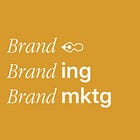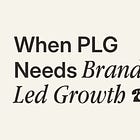Every founder wants their company to have a great brand, but few have the training to ensure it happens, and most have a desire for control that gets in the way. These 10 rules are meant to help founders and their teams develop a brand that builds trust, authentically differentiates, and drives revenue from very early in the company lifecycle.
If you’re new here, this newsletter focuses on helping brand operators get buy-in and influence inside their companies, especially at tech companies that tend to be product-first, founder-led, and performance-obsessed. If that’s you, I’m about to take you to school. 🚍
You’re here because you signed up for one of my resources—my Maven course waitlist, my lightning lesson on brand strategy, or my Notion templates.
If someone sent you this post and you’re not subscribed, join those people learning how to tactically advocate for brand at your company.
If you work in a founder-led company, you learn firsthand how much a founder’s opinions and personal tastes inform brand, company culture, hiring practices, and product strategy.
This can be a boon—in rare cases where the founder is truly a polymathic visionary. More often, uninformed founder opinions and personal tastes end up derailing valuable, data-backed work targeted at what makes the most sense for the competitive landscape, the audience, or the future roadmap. If you’re a founder reading this, thanks for being here—and don’t fall into the ego trap!
10 Brand Rules for Founders
1. You have a brand, whether or not you’re building it on purpose.
Your brand exists from day one. Whether you actively shape it or not, your brand starts forming the moment your company does.
Brand informs all aspects of your business. Your brand isn’t just for marketing—it should influence product development, customer service, hiring practices, and company culture. It’s the thread that ties everything together. Every customer interaction, product decision, and public communication contributes to your brand image—support emails, onboarding UX, founder interviews, rewards programs, inclusion on “best of” lists.
You can build a product and make sales without investing in brand at all. But you still have a brand. Your brand might just look like everyone else’s, signal you’re a downmarket product when you’re trying to sell upmarket, draw in the wrong customers, get mistaken for another product/company…the list goes on.
Founders, don’t fall for the myth that great brands are born, not made. It takes purposeful effort over the short and long term to envision, nurture, and harvest the benefits of a thriving brand. You’re obsessing about product and growth—add brand to the list and see what unlocks.
This post, where I break down brand, branding, and brand marketing, is a great place to start to make sure you’re not conflating the terms:
2. You are not the brand, but you are part of it.
There’s one caveat to be made here: If you’re on day one of building your company, then, yes, you are the brand. (Head back to What Do We Mean by “Brand”? for more on this.)
But I mean literally day one. From day two onward, you become a reflection of what your overarching brand stands for and promises its customers. How do you best leverage that role? First, in very few cases are you, the founder, the company’s exact target audience or the ICP (ideal customer profile). Your background may lend you much greater understanding about the challenges your audience faces—that’s excellent empathy to leverage. But unless you’re building a product for founders (and even then…), your day-to-day challenges, where you get information, and how you compare products are not the same as your ICP’s.
Your personal opinions might be tasteful and sometimes proven right, but it doesn’t mean they’re automatically informed. Many founder’s instincts are also, frankly, often completely wrong, especially on topics outside their area of expertise. (Someone needed to say it.)
Your job here is to spend the time interrogating your own biases while articulating the company’s long-term vision and goals. Listen personally to customers, analyze the competitive landscape, and allow space for your team to push back or question your taste. On the other hand, if you’re trying not to be overly involved, know that your behavior and actions will always trickle down to the brand in some way. Are you aware of the ways they do?
My post on what taste means at work goes deeper:
Your personal brand and company brand can serve each other, but it’s best to keep them distinct. A more customer-focused brand is often better than a cult of personality.
3. You need product-market fit. And brand-market fit.
Product-market fit ensures you’re solving the right problem for the right market. Brand-market fit ensures your brand resonates with that target market.
How brand-market fit complements (not replaces) product-market fit:
While product-market fit focuses on solving a specific problem or fulfilling a functional need, brand-market fit addresses the emotional and psychological aspects of customer engagement.
Product-market fit gets a company into the market, but brand-market fit helps companies differentiate themselves in crowded markets, where multiple products may solve similar problems (e.g. commodities).
Brand-market fit ensures a unified customer experience. It aligns every touchpoint of the customer journey—from product functionality to marketing to customer support to sales—to create consistency and, in turn, trust.
Product-market fit gets you in the game. Brand-market fit helps you win it. This one is worth going deep on (with examples of companies with strong and weak BMF):
4. Brand is about making money.
Brand isn’t a cost center—it’s a revenue driver. A strong brand drives customer acquisition, retention, and loyalty; a strong brand helps you command premium prices and expand into new markets or product categories.
You can invest in branding for free no matter what stage of growth you’re at (a topic I covered in an earlier post) and make an investment that pays dividends in the form of reduced long-term marketing costs and increased customer lifetime value.
When I talk with founders, there’s sometimes an underlying assumption that I’m about to pitch them a six- or seven-figure agency partnership and throw up a bunch of random billboards. Once we get into it (and I frame up the principles in this list), they realize how much low-hanging fruit 🍈 has been right in front of them. Brand has, unfortunately, become conflated with cost centers—huge campaign and media budgets, long timelines, or headcount for strategists who “think about work, but don’t actually do it” (I don’t agree with this, but it’s out there, at least in tech). This way of thinking does everyone a disservice.
The real mistake isn’t spending money on branding or brand marketing—it’s spending money before you’ve gotten alignment on what you’re working toward or who the product is for—or spending only on growth marketing like Google and Meta ads without brand awareness, which is expensive.
Brand marketing is the umbrella that sets the highest-level strategy (your mission, what you do/your value prop, who you’re for, and how you do it differently) that growth and product marketing support. Not all growth marketing is brand marketing, and not all product marketing is brand marketing. But all brand marketing is growth marketing, and all brand marketing is product marketing. Early-stage startups often choose a growth or product marketer as their first marketing hire, with the intention of spinning up Meta/Google ads and incrementally improving their targeting. My take is that hiring a brand expert first is often the better choice—let them hire a growth expert (or agency) once brand foundations are in place.
Why? Because growth engines fly when fueled by a strong brand. There’s no chicken and egg question here—any product that’s selling well has a good-enough brand. Without meeting a certain bar, no amount of spend on demand gen will be enough—if you bring a developed brand to the table, you empower your channel spend to move key metrics like LTV, CAC yield, and profit margin.
5. Brand differentiates better than features.
Most products are commodities. When you sell a commodity, your brand is often the best (sometimes only) way to create meaningful differentiation. It’s what makes you memorable and preferred in a sprawling landscape of similar-seeming offerings.
It’s true; most things we sell and consume, B2B or B2C, are commodities—a product that’s effectively the same, regardless of which manufacturer or brand you buy it from. Brex’s credit cards and banking services are commodity products. Notion’s workspace is a commodity. Gusto’s payroll platform is a commodity. You could get nearly all the same product features and benefits from Ramp, Asana or Google Docs, or Rippling.
That’s not a bad thing—having competitors in your space means there’s a healthy demand for what you’re building, and you don’t have to do all the work of category-building and product education on your own. But competing on features is a short-term game, and competing on pricing is a race to the bottom.
Consider these commodity examples where brand strengths and differences become obvious between successful competitors: Streaming (Netflix and Disney+), AI chat (ChatGPT and Claude), water (Crystal Geyser and Liquid Death).
Some more obviously target different users, but attention and consumer spend is finite, and you’re also competing with other categories beyond your own: Listening to a podcast on Spotify instead of watching TV, typing into Google instead of chatting, refillable water bottles.
Differentiation is your brand’s primary job. Don’t hold it back by betting only on “silver bullet” product ideas. They might pay off (coin flip? 🪙). Investing in your brand will pay off.
Go deeper on why even the best growth strategies, like PLG, won’t work forever without relying on brand:
6. Business goals aren’t mission statements.
Your mission statement should articulate why people should care about your product, not your growth ambitions.
These seem to be conflated more often than not. You need both—but your mission statement shouldn’t be a business goal.
Your customers literally do not care what your business goals are. Your growth ambitions are meaningless to them. Meaning comes from how you solve their problem today and long-term, and how that makes them feel (especially how it makes them look great).
Brex started out with a business-goal-as-mission. Very early on the idea was “A world where Brex is the financial operating system of every business in the world.” Not that dissimilar from Dell’s “A PC on every desk.”
As a business goal, this is fine—it clearly states an intention around ubiquity and the intended market. But the issue with this as a mission statement is that it offers no reason for anyone else to care. The mission should articulate why Brex deserves to be every business’ financial operating system, and why customers should actually want it to be. They probably already have some kind of “financial operating system”; why should they want this one? Now, Brex’s mission has evolved to something where the customer benefit is stronger: “We’re empowering employees anywhere to make better financial decisions.”
Your ultimate business goal, north star, whatever, should be distinctly different from the mission’s goal so that you can separate literal growth targets from “how” the business will get there and its right to win—why is your approach deserving of being the best, the first, the most?
7. Think of brand like compound interest.
Building a brand pays off the same way compound interest does. Consistent, small investments add up, and growth accelerates over time. As your brand grows stronger, each new brand-building effort becomes more effective. Your existing brand equity makes new marketing initiatives more impactful and cost-effective. You create a foundation of trust and familiarity that makes people inclined to care when you do something new. Once you get people’s attention, the goal is to keep it. Then they’ll already be paying attention the next time you have something to say.
Let’s get even nerdier! An early start maximizes returns: The earlier you start saving, the more time your money has to grow. The same is true for brand building. Companies that invest in their brand early on have a significant advantage over those that wait, as they have more time to build recognition, trust, and loyalty.
Brand also helps you withstand market fluctuations. A well-diversified investment portfolio can weather market downturns. In the same way, a strong brand gives you a buffer through industry changes, economic downturns, or PR crises. A great product doesn’t make you immune—brand is your flu shot (if you needed another metaphor). 🩹
When did you start thinking about your product-market fit? That’s about when you should be thinking about your brand-market fit. Don’t wait until your Series C or you’ve hired 200 employees or you’ve hit a growth ceiling to dedicate someone to intentionally focus on the brand.
8. Don’t ship your org chart.
You might’ve heard this in context of product launches. It also applies to how people perceive your brand.
If your emails, sales calls, solutions pages, product interface, billboards, video ads, and social media look and/or sound very different; if the CEO is saying one thing in public speaking engagements than what the product experience is delivering; if half of your team thinks your old campaign message is still relevant—your org chart is showing.
Gaps between customer touch points are usually where inconsistencies (lack of alignment) become obvious. It shouldn’t be apparent to any outsider that different people worked on different parts of the company—implying that different values, beliefs, and ideas exist across different parts of the experience. Remember that, to the customer, your product and brand are one and the same. They don’t care that your “ecosystem” is made up of many sub-products, each built by a different team. They care that your product delivers on its promise, and that your brand speaks to their needs and aspirations.
When teams aren’t aligned about what is important to the customer and what the company’s brand principles are, it’s easy to get lost. Often, this lack of clarity flows from the top. Founders and executives should consistently repeat key brand messages and remind team members of what matters most to customers. You can’t over-communicate this. Enforce rigorous product and performance reviews that hold managers accountable to brand values (a single set, not like 4 different sets). It’s very easy to slip into internal fiefdoms, and very hard to backtrack once two different teams ship disparate experiences—don’t let it happen.
The strength of your brand is a direct reflection of your internal alignment. Customers don’t care about your internal structure. Ensure your brand presents a unified front, regardless of how your teams are organized.
9. Consistency is key, but evolution is necessary.
Consistency is a vital cornerstone of building an enduring, trusted brand. It requires full internal alignment around customer problems and aspirations, company strategy, and aesthetic choices. And it requires structures and processes to support employees facing product and marketing development choices—will this decision support brand consistency?
I’d bet many founders would be shocked by how fragile their team’s alignment is. One exercise I often run with consulting clients is a very simple survey of leaders and team members aimed at identifying alignment gaps (template here), and every time, executives are surprised by how different their perspectives are from working teams and from each other. No fancy workstream here, just a five-minute survey that opens everyone’s eyes to a problem that doesn’t fit into comfortable ROI conversations. This isn’t a “spend this much, get this result” situation; rather, it’s “get on the same page or you’ll continue to struggle.” It’s scary to face the reality that your team has a different story or vision in their head than you do, but it’s a necessary step toward scaling.
But today’s brand may not scale to tomorrow’s. The most successful leaders recognize that brands, like markets, aren’t static, and they don’t exist in a vacuum (or in a set of guidelines). Be prepared to evolve your brand and take the team along for the ride. This can be very challenging—many employees get attached to brands, and can be more resistant to change than customers! This puts the onus on brand operators and corporate leadership to provide data-backed rationale and bring a robust long-term rollout and reinforcement plan to the table. Because when the brand evolves, it’s usually a signal that the product and team (org chart, priorities, etc.) need to change too.
There’s no set playbook for when brands need to evolve. That decision is often driven by market realities (e.g. a new competitor arising, a new innovation launching), which is why founders should start planning early and proactively, and ensure that their team understands that a consistent brand can still be flexible, and should be designed in a way that enables and encourages evolution.
10. You can’t and shouldn’t make every brand decision.
This is the hardest one for the founders I’ve worked with. It takes a big vision and big ego to start and lead a company. It takes thinking you’re really smart. It takes wanting every part of the business to be perfect, and believing that very few people can do whatever needs doing better than you can.
I’m here to tell you that unless you’re an experienced brand marketer or designer, you aren’t a brand expert, no matter how great you think your taste is.
Trust your team. Get out of the weeds. Hire a phenomenal copywriter (FTE, not freelance) and let them get to work. Empower your team with your vision, give feedback early in the process, and stay focused on what makes the customer look great—rather than what matches your personal preferences. Spend your time selling the vision, not obsessing over whether the model in one campaign asset is wearing glasses or not (true story).
Founders consistently stand in the way of their own brand’s success, and I think it’s because colors and words and swag feel personal in a way that product screens don’t. If you feel the brand is really going down the wrong track, distill your thoughts down and discuss with the team. If you feel the brand is on the right track, take yourself out of the review process beyond the high level. There is absolutely no reason founders or executives should be killing individual campaign assets days before a big launch, or nitpicking web copy. If you’re that much smarter than the team you hired, you need to revisit your hiring practices or, more likely, check your ego.
If you remember one thing from this post, let it be that—check your ego, invest in brand (processes, channels, and teams), and reap the benefits.
My 4-week course on Maven, Brand for Growth-Stage Leaders, gets hyper-tactical on how founders can act on all of the principles I laid out above, and how in-house brand operators can navigate founder-led brands. My next cohort starts soon on September 2. You can enroll now or join the waitlist for updates.
If you’re a brand operator
Until the company reaches a certain growth threshold—or let’s be honest, until the founder gets comfortable with being less in the weeds on every creative or product decision—then working with and around founders’ preferences is a necessary part of navigating brand development at your company.
Understanding your founders’ style is key here. Is getting your them to think about core values and mission statements like pulling teeth? Or are they so involved that you can’t get a video script across the line without four(teen) rounds of edits? In that case, can you leverage that enthusiasm as a strength?
If you’re wondering how to do this, subscribe for my upcoming post on working with founders (and other execs) on brand:
For further reading
I chose the rules format for this post because an important book that guided me early in my career is The 22 Immutable Laws of Branding. While a little dated, understanding these “laws” is still worthwhile for anyone who operates a business, makes a product, or shapes a brand. Another is “The 14 New Rules of Brand Strategy” and “The 16 Rules of Brand Strategy” by
, a strategist I’ve been following for a few years now.What did I miss? What else is most important for founders when it comes to brand building?
If you liked what you read, consider:
connecting with me on LinkedIn: Kira Klaas 👩🏼💻
commenting with a question or topic you’d like to see next
sending to a friend 💌 or coworker 💬








So many important ideas in here!
What stands out to me:
"Mission statements are not business goals," --a thousand times yes! It can be huge impact to reframe "business goal missions" around what we're doing for real people and collectively, the world.
Brand as "compound interest" is a great metaphor. Brands are only built over time and with consistent ongoing delivery, so the sooner you start showing up in the best intentional way, the better (stronger, and less expensive to impact).
I really like the idea of hiring a brand specialist as step one, and letting them take on the task of hiring an agency or getting the marketing going.
At my current startup we tried doing marketing before we had an evolved and cohesive brand... and frankly those early marketing efforts were embarrassing. Which was my own fault.
Finally we got our brand specialist, and our new brand, and now marketing feels not only easy but in some sense natural: we already know what we want to say, so we don't have to think of it as we go.